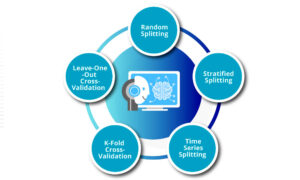Data splitting in machine learning (ML) involves dividing data into training, testing, and validation sets. This method ensures model accuracy and helps construct models.
Data splitting in ML blocks overfitting and determines underfitting. It evaluates model performance on unseen data and optimizes model parameters by utilizing the training set to ensure proper functioning on fresh data.
This blog discusses data splitting in machine learning, its meaning, methods, and importance.
What is Data Splitting in Machine Learning?
Data splitting is the process of separating data into two or more parts. One element is used to test the data in a two-part split, while another element is used to train the model. Training, testing, and validation sets are present in three-part splits.
A crucial component of data science is data splitting, especially when building models with data. This method assists in ensuring the accuracy of data model creation and procedures that rely on them, such as machine learning.
How Does it Work?
While working on supervised machine learning tasks, it is always advised to divide the data into three groups: training, testing, and validation sets. Thus, in the data split process, we initially divided the data into three sets at random.
- Training set: A portion of the primary dataset will be fed into the model to help it understand data patterns.
- Validation Set: This set is used to compare the model’s performance against other models and hyperparameter settings.
- Test set: This set verifies the correctness of the finished model.
Methods of Data Splitting in Machine Learning
1. Random Splitting
Random splitting is a technique for separating a dataset into training, validation, and test sets. The machine learning model is trained using the training set, refined using the validation set, and then tested with unseen data to estimate its generalization capacity.
2. Stratified Splitting
Stratified splitting guarantees uniform class distribution across training, validation, and test sets when working with unbalanced datasets.
3. Time Series Splitting
A technique called time series splitting is used to manage time series data, including stock price, weather, or website visitor statistics. Because observations are founded on prior findings, the chronological sequence of data points is essential and is preserved throughout data division.
Time series splitting divides the dataset into subsets to maintain temporal order, which makes it useful for testing, validation, and training.
4. K-Fold Cross-Validation
A technique called K-Fold Cross-Validation splits a dataset into “k” equal folds so that it may be used for numerous training and validation cycles. With small data sets, it’s a potent technique for evaluating the effectiveness and capacity for generalizing machine learning models.
5. Leave-One-Out Cross-Validation
A thorough cross-validation technique that works well with smaller datasets is leave-one-out cross-validation.
This approach uses the remaining N-1 samples as the training set and each of the N samples as a test sample. This procedure is repeated for every sample, producing N classifiers and N test outcomes. Next, the model’s performance is evaluated by averaging these N outcomes.
Importance of Data Splitting in Machine Learning
- Avoids overfitting: Overfitting is the term for a model that is too well-suited to the training set and unable to generalize to new data. Data splitting avoids this by guaranteeing that the model can function properly on fresh data.
- Detects underfitting: When a model cannot generate correct results for training or test data, it is said to be underfitted. Data splitting can assist in locating and resolving underfitting.
- Evaluates model performance: Splitting data makes assessing a model’s performance on previously unseen data possible. This aids in making decisions about the model’s usefulness.
- Optimizes model parameters: By using the training set, data splitting enables you to optimize model parameters.
Wrapping Up!
In this blog, we discussed data splitting in machine learning. It involves dividing data into training, testing, and validation sets to ensure model accuracy, prevent overfitting, detect underfitting, evaluate performance, and optimize parameters.
Stratified splitting guarantees a consistent class distribution, while random splitting splits the dataset into training, validation, and test sets. Time series splitting manages temporal order, and K-fold cross-validation divides the dataset into equal folds.
For more tech-driven content, keep visiting us at HiTechNectar.
Recommended For You: An Overview of Machine Learning. What can machine learning be used for?



